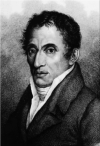Monteggia fracture dislocations: a historical review
- PMID: 24792923
- PMCID: PMC4266382
- DOI: 10.1016/j.jhsa.2014.02.024
Monteggia fracture dislocations: a historical review
Abstract
The eponym Monteggia fracture dislocation originally referred to a fracture of the shaft of the ulna accompanied by anterior dislocation of the radial head that was described by Giovanni Battista Monteggia of Italy in 1814. Subsequently, a further classification system based on the direction of the radial head dislocation and associated fractures of the radius and ulna was proposed by Jose Luis Bado of Uruguay in 1958. This article investigates the evolution of treatment, classification, and outcomes of the Monteggia injury and sheds light on the lives and contributions of Monteggia and Bado.
Keywords: Forearm fracture dislocation; Giovanni Battista Monteggia; Jose Luis Bado; Monteggia fracture; ulna fracture.
Copyright © 2014 American Society for Surgery of the Hand. Published by Elsevier Inc. All rights reserved.
Figures




















References
-
- Monteggia GB. Lussazioni delle ossa delle estremita superiori. In: Monteggia GB, editor. Instituzioni Chirurgiches. 2nd Vol. 5. Maspero; Milan, Italy: 1814. pp. 131–133.
-
- Perrin J. Les fractures du cubitus accompagnees de luxation de l'extremite superieur du radius. In: Perrin J, editor. These de Paris. G Steinheil; Paris, France: 1909.
-
- Bado JL. La lesion de Monteggia. Inter-Medica Sarandi; 1958. p. 328.
-
- Bado JL. The Monteggia lesion. Charles C. Thomas; Springfield, IL: 1959.
-
- Bado JL. The Monteggia lesion. Clin Orthop. 1967;50:71–86. - PubMed
Publication types
MeSH terms
Grants and funding
LinkOut - more resources
Full Text Sources
Other Literature Sources

